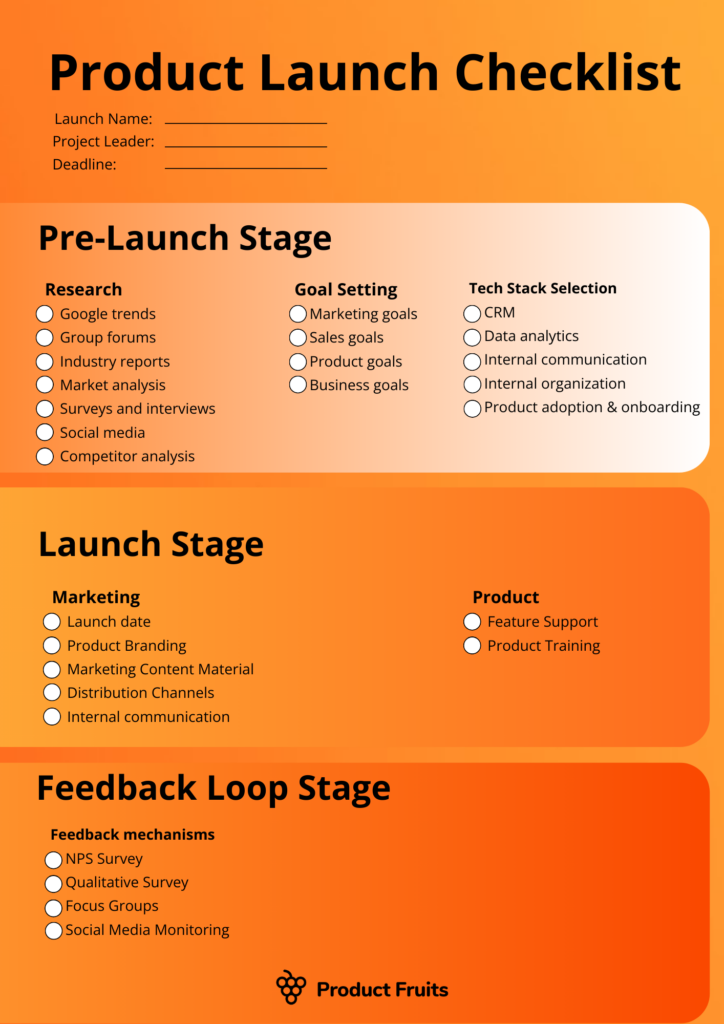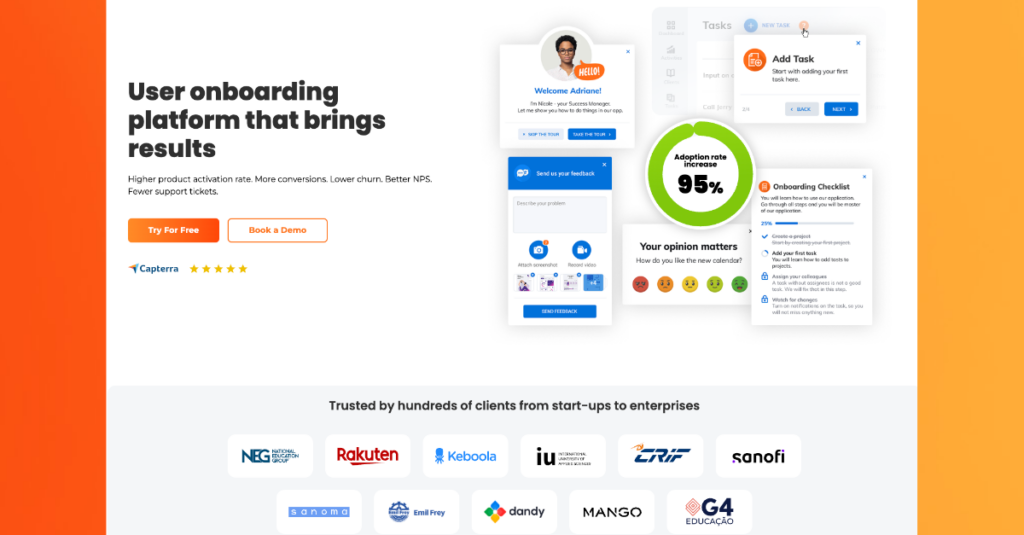
Your product launch checklist is your trusty sidekick. It’s your go-to list to make sure everything’s in line before you hit that big red launch button.
For that very reason, your SaaS product launch checklist needs to be equipped with all the tasks and tips for success. The more you have under consideration, the more confident you’ll become with your decisions and strategy.
Here’s a summary of what we’ll cover in detail below:
If you’re in a hurry to launch the in-app comms around new features, here’s your quick-start free trial link. 👈
A product launch is the process of releasing and announcing your product to the world.
Think of it as your roadmap, your handy checklist to tick off tasks, double-check details and make sure nothing’s slipping through the cracks.
It covers the to-dos of marketing, website planning, product development, and other aspects of launch management to ensure that your launch achieves your goals.
A product launch checklist should be modified to fit your business goals, industry, and product release.

Product launch checklists are helpful organizers to make sure every aspect of a product launch has been thought out, researched, and created.
Apart from the organizational benefits they provide, here are some additional advantages of a SaaS product launch checklist:
A comprehensive product launch involves different stages and sections before you can share your product with the world.
We’ll go into detail for each section, but here’s an overall idea of what the product checklist covers:
Pre-Launch Phase
Goal stage:
Research Stage:
Tech Stack selection and organization
Product Launch Stage:
Marketing Stage:
Feedback Loop Stage
Here’s a Product Launch checklist template you can save for later. It’ll help keep you on track for a successful product launch.
Save this downloadable product launch checklist. It’ll help you prepare and understand the scope of tasks to complete before the launch of your product.

The pre-launch phase dictates the success of a product launch. This stage introduces ambitious (but relevant) goals backed by research and supported by the right tech stack.
This process stage sets the pillars for the rest of the product launch.
For clarity, I’ve divided this section into Research, goal-setting, and tech stack organization.
This involves conducting thorough market research to help define clear goals and objectives, develop a detailed product roadmap, and secure the necessary tech and role resources.
As Matthew Ramirez, Founder of Rephrase, explains, to achieve a product that truly resonates with customers, you need to “have a comprehensive understanding of who the product is intended for and what their specific requirements and desires are.”
Research should be conducted through conversations with different target groups and online research using platforms like Google Trends, Group Forums, and social media.
Here are some ideas to support your research:
Also, we recommend, “Use tools such as SEMrush for your competitor research and Google Trends for your market trends. You can also engage directly with your potential users by conducting surveys and focus groups to understand better what they need and want“
Although it might be tempting to stick to your personal preference, it’s important to approach the research stage with an open mind and a willingness to adapt based on the information gathered.
Good and thorough research will help your product launch avoid pitfalls, loss of time and money, and team determination.
But scraping over research could mean losing time, money, and product launch success– over something avoidable.
Here’s what experts recommend to avoid this mistake.
Alari Aho, Founder of Toggl, states the number one mistake in product launches is… “Failing to align with market trends can make your product seem outdated from the start. Regularly consulting industry reports and engaging with thought leaders on platforms like LinkedIn helps us stay ahead and relevant.”
Jason Hunt, CMO and Founder of Merged Media, shares, “In my experience, one common mistake during the research stage of a product launch is relying solely on quantitative data and neglecting qualitative insights.
While quantitative data such as surveys and analytics can provide valuable information about user behavior and preferences, it often lacks the depth and context that qualitative research can offer.
To avoid this mistake, it’s important to incorporate qualitative research methods such as user interviews, focus groups, and usability testing. These methods allow product managers to gather rich insights about user needs, pain points, and motivations.
By understanding the “why” behind the quantitative data, product managers can make more informed decisions and create products that truly meet user expectations.”

Once the research is completed, it’s time to gather data to spot trends and opportunities for your product launch. This data should be your reference for all decisions and strategy direction.
Different goals should be set up for a product launch. Each “category” should align with one another but reflect the different departments and task forces that make up a product launch.
Separating goals will help with task delegation, setup, and measurement.
Here are common goal categories and prompts to inspire you:
When it comes to setting goals, we recommend keeping an eye on success metrics. Goals vary depending on the product and goals, but some key ones include the number of new sign-ups, user engagement rates, and customer feedback. These metrics provide valuable insights into how well the product is received and where improvements can be made. Tracking these metrics over time is important to understand trends and make data-driven decisions.

3. Set up your tech stack
Your industry research and selected goals will dictate the right tech stack for your business. These tech platforms will aid you in communicating, internally organizing, and managing your data throughout the entire product lifestyle.
The more integrations and communication between platforms, the higher the ability to organize, manage, and mitigate problems during the product launch.
You want to avoid users having to source information from different data points, as this can lead to confusion, misinformation, and data loss.
Here are a few tools to consider:
When it comes to advise on tech stacks, we recommend the following platforms: “You’ll need a CRM like HubSpot, Google Analytics to track website visitors, and a tool to track signups like Amplitude.” CRM tools like HubSpot are particularly helpful—HubSpot’s suite of marketing, sales, and service software supports end-to-end management of your product launch, from initial outreach to post-launch follow-up, ensuring a seamless customer journey.
Facilitate goal and task expectations, knowledge sharing, and team communication with async tech platforms. These platforms help your team centralize efforts and keep each other in the loop on product launch progress.
We recommend project management tools like Asana and Trello for organizing tasks and timelines. Slack makes it easy to collaborate with team members.
Data is the backbone of all product launches. Although you can source data from different platforms, we recommend using Google Analytics as your starting base, thanks to its ability to track events, sources, and website conversions.
For analytics, we recommend “Google Analytics and Mixpanel are critical for tracking website traffic and user behavior, providing real-time data to pivot and optimize your launch strategy as needed.”
Digital Adoption platforms help educate users on how to use your app, engage with features, and immediately find value in the platform.
The best tool available is Product Fruits. It’s a no-code user onboarding solution with all the features and tools you need for users to adopt your platform.
Product Fruits allows companies to customize onboarding to their brand and users’ needs, with tailored user segmentation options and the ability to integrate with your tech stack.
Through Product Fruits, companies reduce user churn by 70% and increase user onboarding by 29%.

The launch phase concerns your communication and initial impressions of your product.
The main focus is on two areas: product and marketing
Ask yourself: when will my product launch be best received?
Choose a launch time that is preferably away from any major holidays. You want all the decision stakeholders to be present, so lean away from religious, bank, or school holidays for the initial launch to get the most buzz and interest.
Ask yourself: How will your product stand out against competitors and the industry?
Consider your USP and current competitor landscape. You’ll want to center most of your marketing and communication on what makes your product unique and how it solves your target users’ problems.
Along with messaging, you’ll also need to choose the right price point, which will make a statement about your brand position.
👀 6 Experts reveal how to enhance brand strength during user onboarding

Ask yourself: what channels will bring me the most profit?
Regarding marketing, there are two main channels to focus on: Paid and Organic.
Choose paid: This is the best option for you if you have a new product, can invest in upfront costs, and require immediate awareness.
Choose organic: If you have a long-term goal and marketing strategy, the organic approach will earn your steady and loyal customers higher trust than paid media sources.
Depending on your product and marketing needs, here are different marketing materials for launch:
The important thing is that all marketing material echoes the same message.
Ask yourself: How can I reach my target audience?
Understand which distribution channel will be the most impactful for your audience.
For example, if you’re an e-commerce platform, you’ll likely be able to target your demographic and their interests on Instagram, where they scroll for inspiration and fashion, rather than catching them on LinkedIn when they’re at work.
Conversely, you’re more likely to move a product manager to action promoting your business on LinkedIn than you would on a social channel like Instagram or TikTok.
Consider the following channels for promotion:
For promotion, the Marketing Specialist at ProductFruits warns that the most common mistake is ” not building enough buzz and anticipation about the product in the right communities. PMs should find out where their Target Group hangs out and participate in conversations. This not only helps in creating anticipation about the launch but also optimizes messaging accordingly.”
Plan your marketing content around the distribution channels that will reach your target audience.
Ask yourself: How will I share and communicate information with my team?
Continuous internal communication helps to keep all teams aligned on the goals and messages around a product launch.
It’s helpful to set up weekly or monthly syncs, share information on progress, or even do workshops to engage the entire company on a new product launch.
Fruity Tip: Use centralized storage for all documents and information related to sales and marketing. This allows easy access for each department to strengthen and engage with your brand.
The product stage of a product launch revolves around product communication, user experience, and onboarding.
At this stage of the product launch, you should have answers to the following questions:
Fruity pro-tip: Before launching your product, have clear tools and protocols in place to quickly onboard users, offer immediate support and increase product adoption throughout each lifecycle.
Onboarding tools such as product tours, checklists, hints, and tooltips can help you achieve user adoption and support.
Opt to include webinars to host FAQs and expert panels, or take a peek at 12 Onboarding email examples to increase the trial to conversion in 2024
In this stage, you gather customer feedback and incorporate it into future product iterations.
Feedback allows you to identify potential issues or areas for improvement and understand what aspects of your product resonate with your target audience—directly from them.
Effective feedback loops involve actively seeking out and listening to customer feedback. This can be done through surveys, focus groups, or even just asking individual customers for their thoughts.
By continuously incorporating customer feedback, you can ensure that your product meets the needs and expectations of your target market, ultimately leading to a more successful launch and long-term success.

There are several ways to receive feedback from users. Whether you choose in-app channels or in-person, you must keep questions unbiased and open to truly understand your customers’ needs.
A product launch is the exciting first step in a long process of user adoption. The next step is to get your customers to stick to your product, engage with it, and become avid users.
With Product Fruits, you’ll get all the tools and features you’ll need to support and engage your users on your platform. These include product tours, user onboarding checklists, surveys, and tooltips, all with broad customization and personalization options to make onboarding flows unique to each user.
It’s a no-code solution that acts as an invisible layer on top of your platform, enabling you to improve the user experience and delight customers continuously.
Or, book a call with our onboarding specialists to get tailored advice and recommendations for your business.